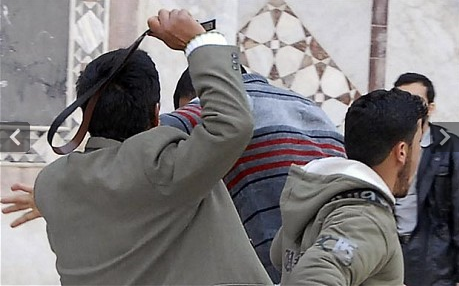Syrian Troops Kill Protesters at Friday Rallies
Security forces in Syria fired tear gas and live ammunition Friday to disperse thousands of demonstrators who took to the streets of Damascus and at least 10 other towns and cities after noon prayers, according to protesters, witnesses and accounts posted on social networking sites. At least 32 people were killed, they said, though it was not possible to immediately verify that toll.
The breadth of the protests — and people’s willingness to defy security forces who deployed en masse — painted a tableau of turmoil in one of the Arab world’s most repressive countries. In scenes unprecedented only weeks ago, protesters tore down pictures of President Bashar al-Assad and toppled statues of his father, Hafez, in two towns on the capital’s outskirts, according to witnesses and video footage.
In the capital, a city that underlines the very prestige of the Assad family’s four decades of rule, hundreds gathered after prayers at Al Hassan Mosque. Some of them chanted, “The people want the fall of the government,” a slogan made famous in Egypt and Tunisia. Security forces quickly dispersed the protests with tear gas, witnesses said.
But larger protests gathered on the capital’s outskirts, drawing thousands. Other demonstrations occurred across Syria, from Qamishli in the east to Baniyas on the coast.
“Freedom! Freedom!” went another chant. In Baniyas, a banner denounced Mr. Assad and his ruling Baath Party: “No Baath, No Assad, we want to free the country.”
Razan Zeitouneh, an activist with the Syrian Human Rights Information Link in Damascus, basing her account on witnesses, said 10 people were killed in Azra, in southern Syria; two near Homs, Syria’s third-largest city; and 12 in the suburbs of Damascus, the capital.
In Homs itself, where major protests erupted this week, activists said large numbers of security forces and police in plain clothes flooded the city, putting up checkpoints and preventing all but a few dozen from gathering. One resident said streets were deserted by afternoon, the silence punctuated every 15 minutes or so by gunfire.
Abu Kamel al-Dimashki, an activist in Homs reached by Skype, said that 16 of those who were protesting went missing. His account could not be confirmed.
“I tried to go there, but I couldn’t,” he said. “The secret police are all over Homs.”
One of the bloodiest episodes occurred in Azra, about 20 miles from Dara’a, a poor town in southwestern Syria that helped unleash the uprising. A protester who gave his name as Abu Ahmad said about 3,000 people had marched toward the town square when they came under fire. He said he brought three of those killed to the mosque — one shot in the head, one in the chest and one in the back — the oldest of whom was 20.
“There is no more fear. No more fear,” Abu Ahmad said by telephone. “We either want to die or to remove him. Death has become something ordinary.”
The aim of both sides is the same: to prove they have the upper hand in the biggest challenge yet to the 40-year rule of the Assad family. While organizers were reluctant to call Friday a decisive moment, they acknowledged that it would signal their degree of support in a country that remained divided, with the government still claiming bastions of support among minorities, loyalists of the Baath Party and wealthier segments of the population.


